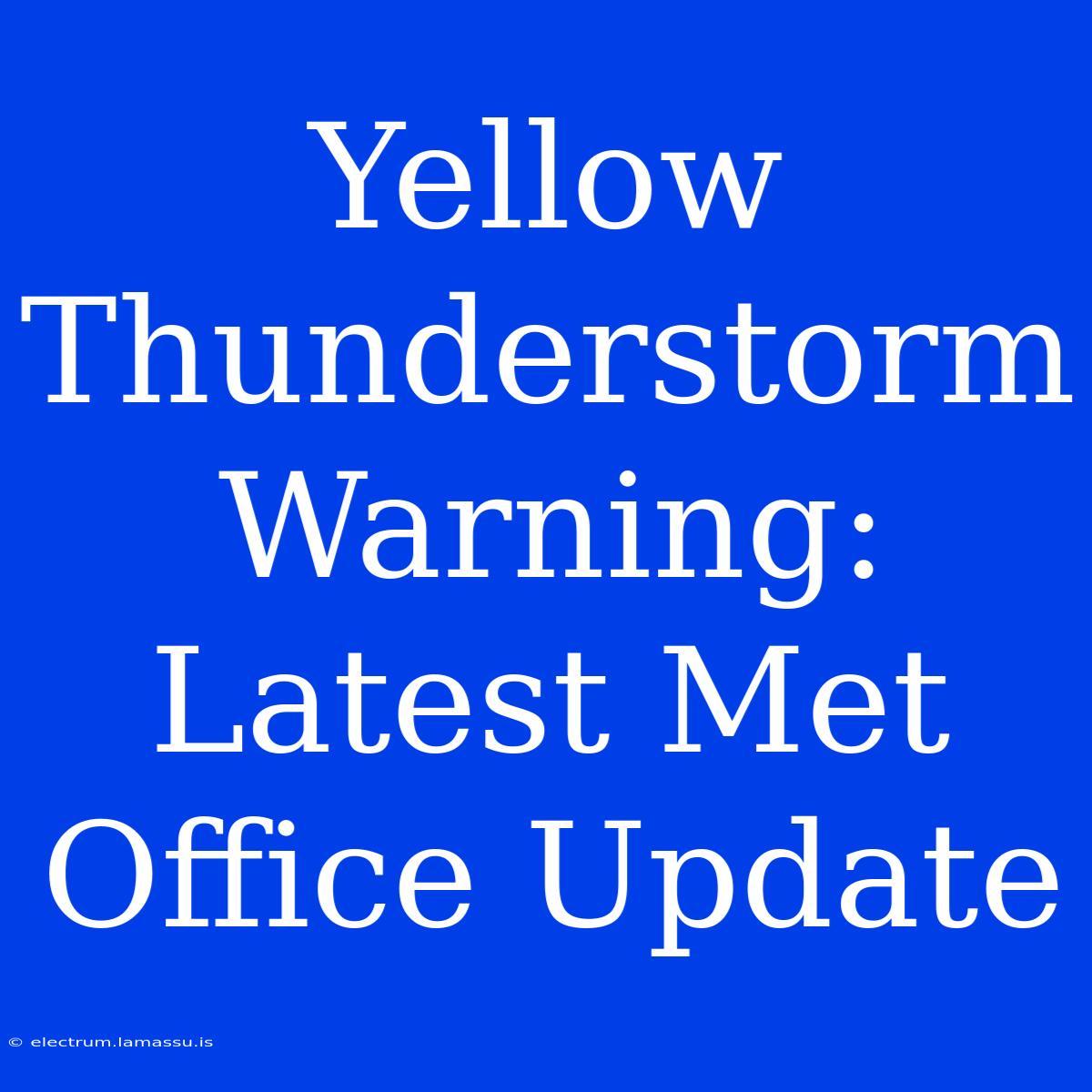Yellow Thunderstorm Warning: Latest Met Office Update
Is a yellow thunderstorm warning enough to worry about? Yes! A yellow thunderstorm warning from the Met Office signals the potential for disruptive weather, and understanding its implications is crucial for safety and preparedness. Editor Note: This article provides insights into the latest Met Office yellow thunderstorm warning, helping you navigate potential disruptions and stay informed.
Understanding why this topic is important is crucial. A yellow thunderstorm warning signifies a heightened risk of thunderstorms, potentially leading to flash flooding, travel disruptions, power outages, and even property damage. This knowledge empowers you to take necessary precautions, minimizing potential risks.
Analysis This article delves into the latest Met Office yellow thunderstorm warning, analyzing its key aspects, potential impacts, and mitigation strategies. We have meticulously reviewed the Met Office updates, weather forecasts, and expert advice to offer a comprehensive guide for informed decision-making.
Key Takeaways
| Aspect | Description |
|---|---|
| Severity | Yellow indicates potential for thunderstorms with impacts but less severe than amber or red warnings. |
| Timing | The warning specifies the duration and areas affected by the potential thunderstorms. |
| Impacts | Potential impacts include heavy rain, flash flooding, strong winds, hail, and lightning. |
| Mitigation | Stay updated on weather forecasts, prepare for potential power outages, avoid unnecessary travel, and seek shelter during thunderstorms. |
Yellow Thunderstorm Warning: Understanding the Risks
Introduction: This section focuses on the implications of a yellow thunderstorm warning, shedding light on its potential impacts and the importance of staying informed.
Key Aspects:
- Thunderstorm Formation: Understanding the conditions that create thunderstorms is vital for interpreting warnings.
- Heavy Rainfall: Heavy rainfall associated with thunderstorms can lead to flash flooding in low-lying areas.
- Strong Winds: Gusty winds can cause damage to property and disrupt travel.
- Lightning Strikes: Lightning poses a significant risk to life and property.
Discussion: The Met Office's yellow thunderstorm warning highlights the risk of disruptive weather, prompting proactive measures to ensure safety. Understanding the dynamics of thunderstorm formation, the potential for heavy rainfall, strong winds, and lightning strikes empowers you to take informed decisions for your safety and well-being.
Flash Flooding: Navigating the Risks
Introduction: Flash flooding is a significant risk associated with thunderstorms. This section delves into understanding flash flood risks and strategies to minimize their impacts.
Facets:
- Risk Factors: Heavy rainfall intensity, urban areas with limited drainage, and mountainous terrain contribute to flash flood risks.
- Potential Impacts: Flooding can damage property, disrupt transportation, and pose risks to life.
- Mitigation: Avoid low-lying areas, stay informed about flood warnings, and be prepared for evacuation if necessary.
Summary: A yellow thunderstorm warning underscores the potential for flash flooding, necessitating vigilance and proactive measures to minimize risks. Understanding the risk factors, potential impacts, and mitigation strategies allows for informed decision-making during a thunderstorm warning.
Power Outages: Staying Prepared
Introduction: Thunderstorms can disrupt power supply, leading to outages that affect daily routines. This section explores the potential for power outages during thunderstorms and provides tips for preparedness.
Further Analysis:
- Causes: Strong winds, lightning strikes, and heavy rainfall can damage power lines, leading to outages.
- Impacts: Power outages can disrupt essential services, communication, and daily life.
- Preparedness: Charge electronic devices, have a backup power source, and know emergency contact numbers.
Closing: A yellow thunderstorm warning necessitates preparation for potential power outages. Understanding the causes, impacts, and mitigation strategies empowers you to minimize disruptions and ensure a smooth transition during power outages.
FAQs
Introduction: This section addresses common questions concerning yellow thunderstorm warnings, clarifying misconceptions and providing valuable information.
Questions:
- What does a yellow thunderstorm warning mean? A yellow warning signifies a potential for disruptive thunderstorms.
- What are the potential impacts of a yellow thunderstorm warning? Impacts include heavy rainfall, flash flooding, strong winds, hail, and lightning strikes.
- What should I do during a yellow thunderstorm warning? Stay informed, prepare for potential disruptions, and follow safety advice.
- How do I stay updated on weather forecasts? Consult the Met Office website, weather apps, and local news channels.
- What are the signs of an impending thunderstorm? Darkening skies, gusty winds, and distant thunder are all potential indicators.
- What is the difference between a yellow, amber, and red thunderstorm warning? Yellow is the least severe, while amber indicates a higher risk, and red denotes extreme danger.
Summary: Understanding yellow thunderstorm warnings, their potential impacts, and safety protocols is crucial for navigating potential disruptions.
Tips for Navigating Yellow Thunderstorm Warnings
Introduction: This section provides practical tips for staying safe and prepared during a yellow thunderstorm warning.
Tips:
- Stay informed: Monitor weather forecasts from reliable sources like the Met Office.
- Prepare for power outages: Charge electronic devices, have a backup power source, and stock up on essentials.
- Avoid unnecessary travel: Limit outdoor activities, avoid driving during heavy rain, and postpone outdoor events.
- Seek shelter during thunderstorms: Move indoors during thunderstorms, avoid open areas, and stay away from windows.
- Be aware of your surroundings: Watch for signs of potential flooding and be prepared for evacuation if necessary.
Summary: Taking proactive steps during a yellow thunderstorm warning can significantly minimize potential risks.
Concluding Remarks: Understanding the significance of yellow thunderstorm warnings empowers you to take proactive steps, ensuring safety and preparedness. By remaining informed about potential weather impacts, utilizing preparedness strategies, and following safety protocols, you can navigate potential disruptions with greater confidence and minimize risks during thunderstorms.

